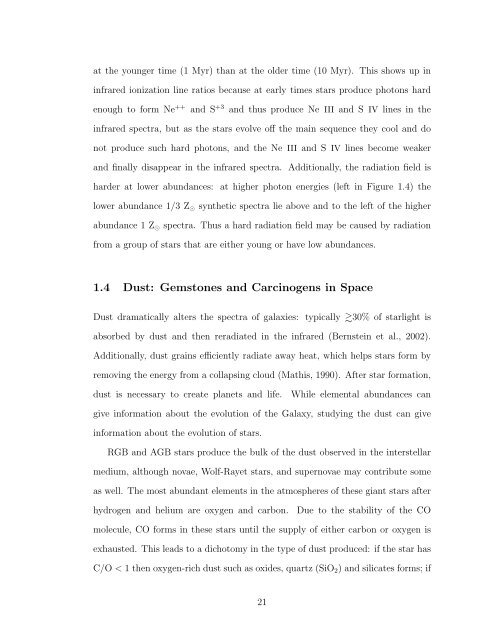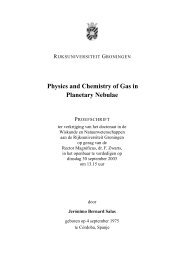TRACING ABUNDANCES IN GALAXIES WITH THE SPITZER ...
TRACING ABUNDANCES IN GALAXIES WITH THE SPITZER ...
TRACING ABUNDANCES IN GALAXIES WITH THE SPITZER ...
Create successful ePaper yourself
Turn your PDF publications into a flip-book with our unique Google optimized e-Paper software.
at the younger time (1 Myr) than at the older time (10 Myr). This shows up in<br />
infrared ionization line ratios because at early times stars produce photons hard<br />
enough to form Ne ++ and S +3 and thus produce Ne III and S IV lines in the<br />
infrared spectra, but as the stars evolve off the main sequence they cool and do<br />
not produce such hard photons, and the Ne III and S IV lines become weaker<br />
and finally disappear in the infrared spectra. Additionally, the radiation field is<br />
harder at lower abundances: at higher photon energies (left in Figure 1.4) the<br />
lower abundance 1/3 Z⊙ synthetic spectra lie above and to the left of the higher<br />
abundance 1 Z⊙ spectra. Thus a hard radiation field may be caused by radiation<br />
from a group of stars that are either young or have low abundances.<br />
1.4 Dust: Gemstones and Carcinogens in Space<br />
Dust dramatically alters the spectra of galaxies: typically �30% of starlight is<br />
absorbed by dust and then reradiated in the infrared (Bernstein et al., 2002).<br />
Additionally, dust grains efficiently radiate away heat, which helps stars form by<br />
removing the energy from a collapsing cloud (Mathis, 1990). After star formation,<br />
dust is necessary to create planets and life. While elemental abundances can<br />
give information about the evolution of the Galaxy, studying the dust can give<br />
information about the evolution of stars.<br />
RGB and AGB stars produce the bulk of the dust observed in the interstellar<br />
medium, although novae, Wolf-Rayet stars, and supernovae may contribute some<br />
as well. The most abundant elements in the atmospheres of these giant stars after<br />
hydrogen and helium are oxygen and carbon. Due to the stability of the CO<br />
molecule, CO forms in these stars until the supply of either carbon or oxygen is<br />
exhausted. This leads to a dichotomy in the type of dust produced: if the star has<br />
C/O < 1 then oxygen-rich dust such as oxides, quartz (SiO2) and silicates forms; if<br />
21













